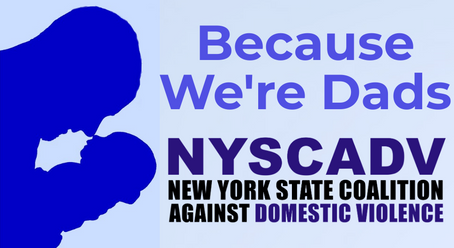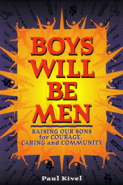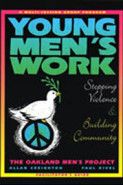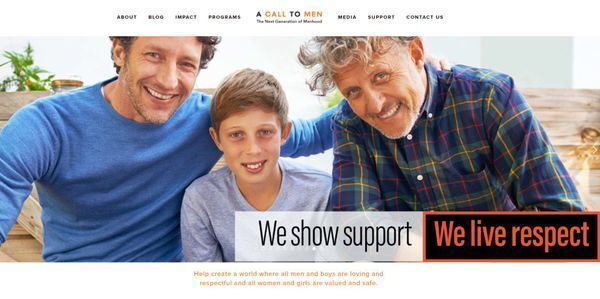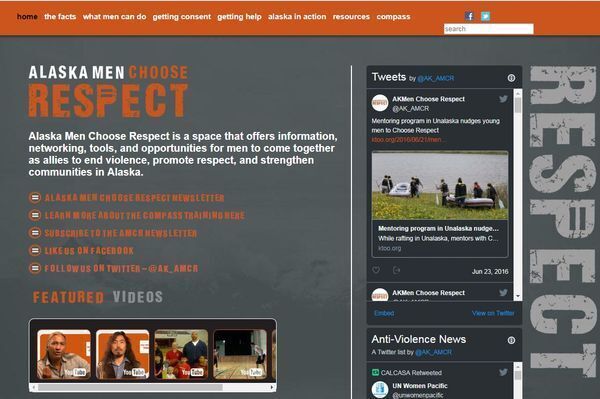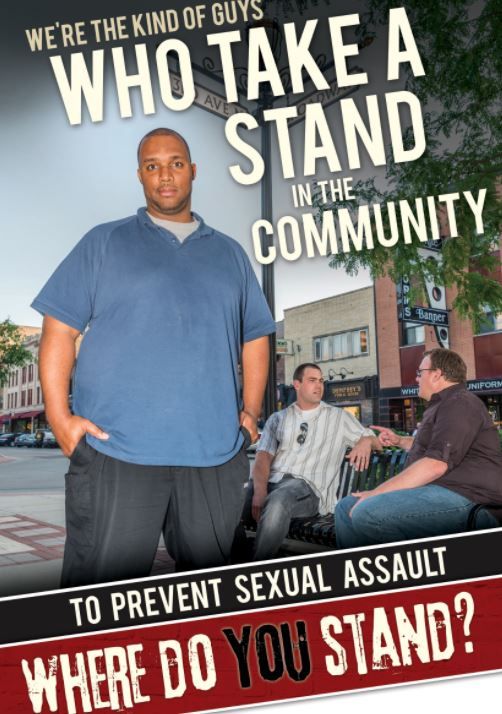-
The NYS Coalition Against Domestic Violence (NYSCADV) recognizes the impact fathers and father figures have on promoting women's rights, gender equality, and healthy relationships. Fathers play a significant role in the lives of their children and have the opportunity to influence attitudes and behaviors that support healthy and equitable relationships premised on respect, consent and nonviolence. To highlight the impact that fathers and father figures have on our lives NYSCADV, in collaboration with Rus Funk who has been working for more than 20 years on efforts to engage and mobilize men and boys is pleased to present Because We’re Dads: Reaching and Mobilizing Fathers to Promote Gender Equality.
ACADEMIC ARTICLES AND REPORTS
-
While a lot of effort and attention is being spent to “engage men” in addressing, responding to and preventing gender-based violence, the term has not been defined in any specific or concrete ways. There is some vague idea, often, about what it might mean for men to be engaged, but without a clearer understanding of what we mean by “engaging”, we’re often left with a lack of clarity in terms of goals, objectives and related activities. Rus Funk.
-
Men are differently positioned in the degree to which they are willing and able to become engaged in efforts to prevent gender-based violence or promote gender equality. Effectively engaging men suggests that first, the focus is on those men who are most willing to be engaged. Rather than trying to convince those men that they need to take gender-based violence seriously or that they should care (such as men who are “hostile, resistant or uninterested”), efforts are more effective that focus on those men who are willing to be engaged and strategically designing initiatives and efforts that are meant to meet them at their point of engage-ability. Rus Funk.
-
Efforts to engage, mobilize and organize men to work to prevent gender-based violence have grown in scope and variety over the past 25 years. As these efforts have developed, significant lessons have been learned about effectively engaging men and boys and about how to do so in ways that meet some standards. These standards have not, to date, been spelled out in any one place. The standards provided here are gathered from a number of sources and are offered as a recommendation for practitioners, campuses, organizations and coalition as they develop or expand engaging men initiatives. Rus Funk.
-
The Department of Justice Office on Violence Against Women (OVW) “2014 Current Practices and Challenges Engaging Men on Campus” provides insight into how 2014 OVW Campus Program grantees fostered men as allies in the prevention of sexual assault, domestic violence, dating violence and stalking. The assessment also provides effective theories and comprehensive steps to engage men in prevention.
-
This report outlines findings from a participatory learning and action project conducted by the Western Balkan Gender-Based Violence Prevention Initiative funded by the International Center for Research on Women and Care International. It also contains recommendations for education modules to be facilitated for young men to explore notions of masculinity and its’ relationship to violence, particularly gender based violence. Discussion items include: exploring youth culture, gender norms, socialization of masculinity, power and influence, attitudes about violence, root causes and consequences of violence, exploring transition from boyhood to manhood, and moving toward change.
-
From work with men and boys to changes of social norms and reduction of inequities in gender relations: a conceptual shift in prevention of violence against women and girls. Rachel Jewkes, Michael Flood, James Lang.
-
Men's Action Network Alliance to Prevent Sexual and Domestic Violence developed this report to discuss ways in which men can get involved in prevention efforts.
-
Abstract: Despite growing male participation in ending violence against women, little is known about the factors that precipitate men's engagement as antiviolence “allies.” This study presents findings from a qualitative analysis of interviews with 27 men who recently initiated involvement in an organization or event dedicated to ending sexual or domestic violence. Findings suggest that men's engagement is a process that occurs over time, that happens largely through existing social networks, and that is influenced by exposure to sensitizing experiences, tangible involvement opportunities and specific types of meaning making related to violence. Implications for models of ally development and for efforts to engage men in antiviolence work are discussed.
-
SUMMARY. This short article details the initial findings from a 3-month conversation between 21 male activists who work to prevent violence against women. Using Participatory Action Research methodology, this research project investigates what men who do this work would like to learn from other men who do this work. To date, no research has been done that examines what it is that motivates and sustains men who work, as their primary effort, to prevent men’s violence against women. This article examines some of the initial findings from this research, and examines the implications for engaging and mobilizing other men to prevent men’s violence against women. This article begins with a description of the research project, followed by an overview of the findings, continues with a discussion of the implications from these initial findings for preventing men’s violence against women, and ends with some lessons learned from the process of this research project and a brief overview of the next step of this conversation. Rus Ervin Funk.
-
This report summarizes findings from the Preventing and Addressing Intimate Violence when Engaging Dads (PAIVED) research study funded by the Office of Family Assistance (OFA) and overseen by the Office of Planning, Research, and Evaluation (OPRE). Child Trends and their partners, Boston Medical Center and Futures Without Violence, conducted the study, which examines how RF programs aim to prevent and address IPV through their fatherhood programming. Specifically, this report presents information about the approaches that RF programs take to provide IPV-related services. It also discusses challenges and successes to providing these services, promising practices, and areas for growth.
-
Transcript from Beth E. Richie’s talk in which she discusses the need for more robust, honest analysis of racism in our movement, talks about what a women of color feminist analysis or perspective or set of principles can offer that is a more promising, more radical approach to reimaging our work, and discusses prison abolition as the most direct path toward justice, one that offers us the best possibility of redemption of our radical roots.
-
This case study was published as an appendix to “Young Men as Allies in Preventing Violence and Abuse: Building Effective Partnerships with Schools” by Alan Berkowitz, Peter Jaffe, Dean Peacock, Barri Rosenbluth & Carole Sousa. The article along with additional case studies by Expect Respect, the Family Violence Prevention Fund, GLSEN, Men Can Stop Rape, Mentors in Violence Prevention and the Thames Valley School District.
-
United Nations resolution on accelerating efforts to eliminate violence against women: engaging men and boys in preventing and responding to violence against all women and girls.
-
Abstract: Data from an international sample of 392 men who had attended gender-based violence (GBV) prevention events were used to examine motivations for involvement in GBV prevention work. Participants responded to an online survey (available in English, French and Spanish). The most commonly reported reasons for involvement included concern for related social justice issues (87%); exposure to the issue of violence through work (70%); hearing a moving story about domestic or sexual violence (59%); and disclosure of abuse from someone close to the participant (55%). Using a latent class analysis, we identified four profiles of men’s motivations: Low Personal Connection (22%), Empathetic Connection (26%), Violence Exposed Connection (23%) and High Personal and Empathetic Connection (29%). Participants classified into these profiles did not differ in length of movement involvement but some differences on key ally variables and by global region did emerge. Implications for engagement strategies and future research are discussed.
-
This report reviews the published and grey literature on male engagement strategies for ending VAWG in five sectors across the Global South. Sectors reviewed include economic growth, trade and agriculture, education; governance, law enforcement, and justice systems; conflict, post-conflict and humanitarian assistance; and social development. A broad definition of such violence was used. Violence against men and boys, much of which could be considered gender based, was not considered as part of this review in accordance with stipulated terms of reference. Programs were included in this review on the basis of evaluated impact, lessons learned documentation, and/or innovative program design.
-
This paper assesses the evidence base of the “men for gender equality” field in light of three aspects of its emergence as a field, namely: its un-interrogated use of the category of “men,” its recourse to social psychological accounts of gender norms and the implications of its NGO form for its ability to collaborate with and be accountable to resurgent intersectional feminist mobilizations
ARTICLES
-
Article written by Jackson Katz analyzing the behavior of bystanders facing misogynous violence or heterosexist abuse and how it can appear remarkably similar to the behavior of bystanders in instances of racist confrontation.
BOOKS
CAMPAIGNS
RESOURCES FOR EDUCATORS
-
Barriers Engaging Men Across the Social Ecology Chart. Rus Funk.
-
Engaging Men Across the Social Ecology Chart. Rus Funk.
-
One of America's leading anti-sexist male activists. Recognized for groundbreaking work in the field of gender violence prevention education with men and boys, particularly in sports culture and the military. He has also recently published “The Macho Paradox.” His film, “Tough Guise” can be purchased at www.mediaed.org.
-
Joe is an inspirational, dynamic speaker who works with corporate, civic and community organizations and associations to promote growth, teamwork, and to inform, inspire and initiate individual, communal and societal change that will empower men and women to be their very best – personally, professionally and relationally.
-
A Call to Men created the Live Respect: Coaching Healthy and Respectful Manhood program to help mentors educate and encourage middle and high school boys to examine their attitudes and beliefs about masculinity. The goal of the Live Respect program is to provide educators and mentors with tools to help raise awareness about gender stereotyping and prevent the use of violence and abusive behaviors, while teaching nonviolent and respectful behavior.
-
Men Engage is an umbrella network of community-based organizations and groups, not-for-profits, other non-governmental organizations, institutions, and individuals interested in working with men and boys to promote gender equality in North America.
-
This brochure provides an at-a-glance overview about Northern NY Call2Men: a community-based engaging-men initiative in Warren & Washington Counties in Upstate New York. Northern NY Call to Men provides an avenue for "regular guys" to develop and act as allies in the prevention of violence against women and girls. Northern NY Call2Men's mission statement is "To educate ourselves and others on the social changes needed to end violence against women." The goal in developing the brochure was as one means (of several) for Northern NY Call2Men (NNYC2M) to communicate about who they are and what they do -- to other men/potential members, the community at large, and supporters or stakeholders.
-
The goal of this self-assessment is to assist organizations interested in engaging men and boys to respond to and prevent gender based violence to begin a process of identifying their degree of readiness. This tool is designed to help organizations to identify some general goals for engaging men in the prevention of rape, domestic violence or other forms of gender based violence; as well as engage a systemic review of the specific ways that your organization may be ready to effectively engage, empower, organize and mobilize men to join our efforts to prevent all forms of gender based violence. You are encouraged to engage in this assessment tool as a group. An individual completing this assessment will provide only one perspective as to the answers provided. Having a team who works collectively to complete this assessment will provide you a much fuller view of your organizations degree of readiness. In addition, going through this as a team can help you, as a team (and perhaps as an organization) clarify your goals and vision for engaging men. Thus, simply by completing this assessment, you can find yourselves further along in your collective process towards creating an effective plan for engaging, mobilizing and organizing men in your communities. Rus Funk.
-
Start With Respect is a new resource from White Ribbon New Zealand. It was developed to prevent sexual violence and promote positive male behavior by providing tips for young men on how to start a respectful relationship with women.
-
This play, created by Ben Atherton-Zeman, long time advocate against men’s violence, uses humor and celebrity male voice impressions to bring these topics to audiences in a way that minimizes male defensiveness. An excellent way to engage boys and men to become involved in both self-reflection and violence prevention efforts.
-
Comprehensive list of resources around Engaging Men and Boys in Violence Prevention.
-
What role can men play in building gender equality? How can men be engaged in the work of building a gender-just world? This page offers a guide to the wide range of resources and materials on XY on these issues.
XY is dedicated to promoting men’s involvement in building gender equality, and this means that much of the content on XY is related to these issues. Here however, I have tried to highlight XY’s content in a structured way. This page overlaps with the page offering a tour of XY’s content of engaging men in violence prevention.
-
Overview of XY's content. XY is a website focused on men, masculinities, and gender politics. XY is a space for the exploration of issues of gender and sexuality, the daily issues of men’s and women’s lives, and practical discussion of personal and social change.
-
A bibliography of resources related to violence prevention.
-
What is men's violence against women? What are its causes and consequences? Here are some key readings and reports, on domestic violence, sexual violence, and other forms of violence against women. They include shorter or more accessible pieces and longer discussions and reports.
-
There is an excellent international literature on how best to prevent and reduce men's violence against women. It includes major, systematic reviews of effective practice in this field. In this XY collection, XY presents key reports on and guides to prevention practice.
-
In this XY collection, XY presents short, accessible introductions to the field of violence prevention.
VIDEOS AND WEBSITES
Why Men Should Care
This panel discussion can be used to provide information and context to other men who are interested in organizing men to stop violence and promote gender equity in their own communities. Panelists specifically responding to the War on Women.


